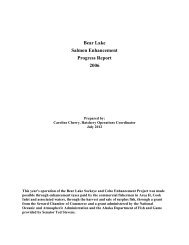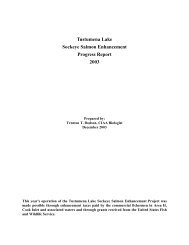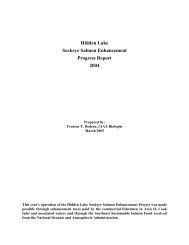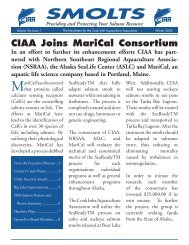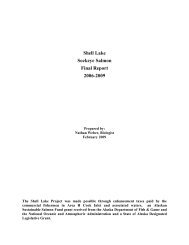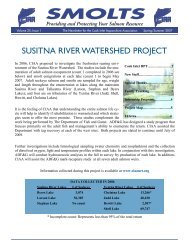Tustemena Lake 2006 - Cook Inlet Aquaculture Association, Kenai ...
Tustemena Lake 2006 - Cook Inlet Aquaculture Association, Kenai ...
Tustemena Lake 2006 - Cook Inlet Aquaculture Association, Kenai ...
You also want an ePaper? Increase the reach of your titles
YUMPU automatically turns print PDFs into web optimized ePapers that Google loves.
INTRODUCTION AND PURPOSE<br />
In July 1993, the Alaska Department of Fish and Game (ADF&G) transferred operation of its<br />
Crooked Creek Salmon Hatchery to the <strong>Cook</strong> <strong>Inlet</strong> <strong>Aquaculture</strong> <strong>Association</strong> (CIAA). Prior to<br />
the transfer of hatchery operations to CIAA, Crooked Creek Hatchery incubated and reared<br />
sockeye (Onchorynchus nerka), coho (O. kisutch) and Chinook (O. tshawytscha) salmon and<br />
steelhead trout (O. mykiss) for release into various water bodies throughout the central and lower<br />
<strong>Cook</strong> <strong>Inlet</strong> drainage. While under CIAA management, the hatchery’s stocking programs focused<br />
on sockeye salmon releases to Tustumena <strong>Lake</strong>, several lower <strong>Cook</strong> <strong>Inlet</strong> <strong>Lake</strong>s and<br />
Resurrection Bay.<br />
In 1993, when CIAA began operating Crooked Creek Hatchery, ADF&G maintained the<br />
responsibility of monitoring the Tustumena <strong>Lake</strong> sockeye salmon smolt migration and adult<br />
escapement. CIAA accepted the responsibility of collecting the gametes (eggs and milt),<br />
incubating the eggs, rearing the fry and releasing the resulting fish to the designated water<br />
bodies.<br />
In November 1996, CIAA terminated operations at Crooked Creek Hatchery, suspended stocking<br />
activities at five lower <strong>Cook</strong> <strong>Inlet</strong> <strong>Lake</strong>s, and transferred the remaining stocking programs to its<br />
Trail <strong>Lake</strong>s and Eklutna hatcheries.<br />
In 1997, the Bear Creek gamete collection procedure and the Tustumena <strong>Lake</strong> fry stocking<br />
program were reviewed by the U.S. Fish and Wildlife Service. The U.S. Fish and Wildlife<br />
Service recommended several changes to these activities, which have been incorporated into the<br />
program.<br />
In 1998, operations at Eklutna Hatchery were suspended, and the hatchery’s Tustumena <strong>Lake</strong><br />
egg incubation and fry rearing activities were transferred to Trail <strong>Lake</strong>s Hatchery. During 1998,<br />
CIAA also assumed the responsibility of conducting the limnological sampling; and, thus<br />
became responsible for conducting all project activities, except the adult escapement monitoring,<br />
which is conducted by ADF&G. Under the this program, approximately twelve million eggs are<br />
3



